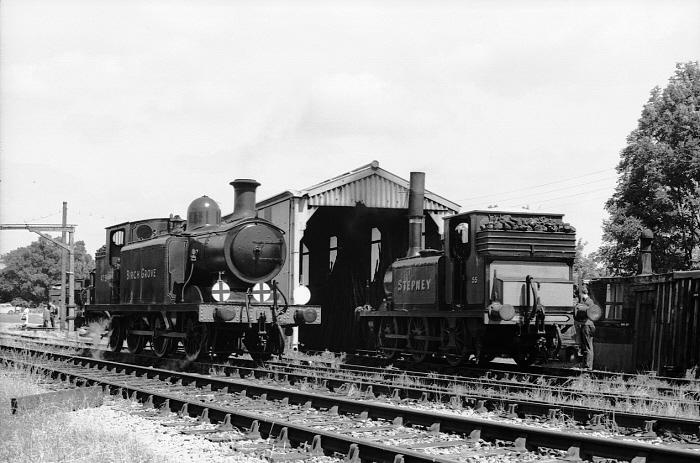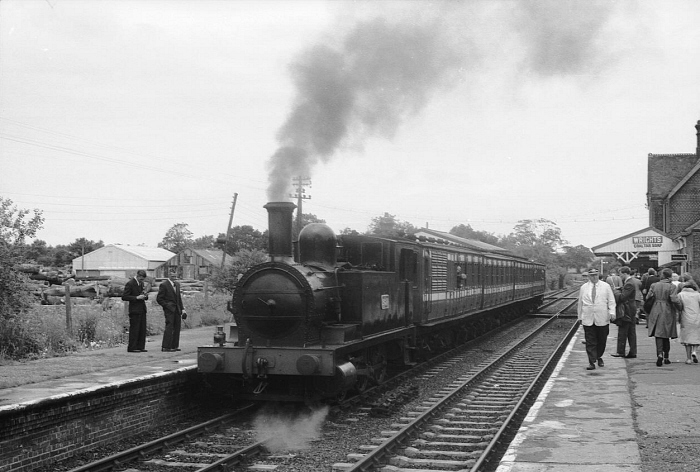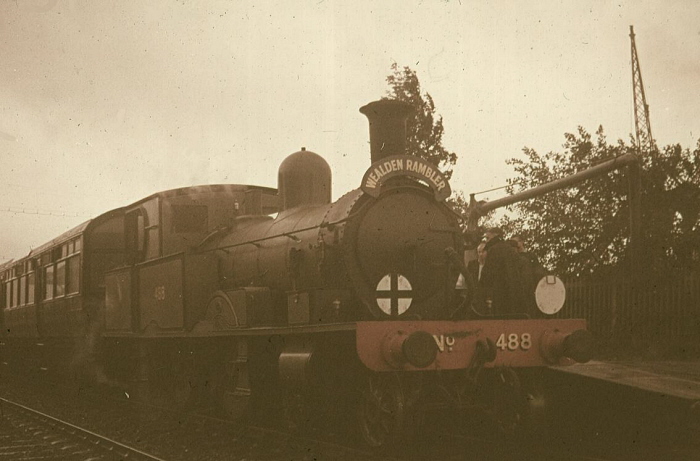
Sheffield Park
Bluebell & Primrose Line
The original ‘’Fletching & Sheffield Park’’ title was abandoned not long after
opening; the prefix was dropped in response to protests from the Earl of
Sheffield. Around the turn of the century, the exposed timber and plaster panel
finish of the Station Master’s house was covered over with vertically-hung clay
tiles, extended down from the triangular roof sections. This was in order to
eliminate leaking during wet weather, and all stations along the line were so
treated. The subsequent Southern Railway era was one of rationalisation at the
site. Circa 1930, the ‘’up’’ platform witnessed the demolition of its timber
waiting shelter (as mentioned earlier, this backed onto the canopy). In
conjunction with this, the canopy was truncated at its southern end, and the
sloping roof section was replaced by a plain timber valance. In 1933, the narrow
gauge line behind the ‘’up’’ platform went out of use, on closure of the
creamery. Two years later, ‘’North’’ and ‘’South’’ signal boxes were
decommissioned, and replaced by a less labour-intensive ground frame upon the
‘’down’’ platform, underneath the canopy.
British Railways was formed in 1948, and a year later, the nationalised
organisation demolished the enclosed timber footbridge. The same fate was dealt
to the structure at nearby Newick & Chailey, but West Hoathly managed to retain
its footbridge until the end. It is likely that at this time, Sheffield Park’s
‘’down’’ platform canopy was truncated at its southern end by about 35-feet,
losing the sloping end roof to a plain timber valance. It was not long, however,
before BR was advertising the inevitable: the withdrawal of passenger services
between Lewes and East Grinstead (Low Level), via the Bluebell & Primrose route.
These were scheduled to cease on 13th June 1955, but upcoming strike action saw
the closure date suddenly brought forward to 28th May of that year – services
vanished without ceremony. Horsted Keynes remained open for goods traffic and
continued to serve the electric working from Seaford.
Little did BR know that the Bluebell & Primrose Line was heading for a temporary
reprieve. A resident of Chailey had studied the original Act of Parliament,
dated 1878, and enshrined within it was the requirement that at least four
trains each way, per day, had to be run along the line for perpetuity. The only
way to formally overturn the ruling was to repeal this Act with a new one, and
consequently, BR was forced to re-open the route to passenger services, on 7th
August 1956. In accordance with the original ruling, just four trains were put
on in either direction, and stations at Barcombe and Kingscote remained closed,
since they were not mentioned in the Act of 1878. Parliamentary powers were
eventually secured, and the Bluebell & Primrose closed for the second time, the
last services running on 16th March 1958 with much ceremony. Once again, Horsted
Keynes remained operational with BR, continuing to serve freight traffic until
5th March 1962, in addition to the Seaford electric service until 28th October
1963.
The preservation movement was swift to act, and the prospect of re-commencing
services along at least a section of the original line was beginning to gather
momentum. The ‘’Bluebell Railway Preservation Society’’ (BRPS) was formed in
March 1959, and Sheffield Park station was soon back in action, after a five
year lease agreement with BR was made. This was for the section of line
in-between Sheffield Park to a point just south of Horsted Keynes, at an annual
rate of £1,850 (£30,990 at 2007 prices). The booking office at the former was
rented at a rate of five shillings per week (£4.15 at 2007 prices). A Light
Railway Order was granted on 9th July 1960, and on 7th August of that year,
steam-hauled services recommenced under BRPS auspices. After BR indicated that
it was not willing to extend the five-year lease agreement after expiration, the
line could only be saved by an outright purchase, and from 1964 onwards, frantic
fundraising took place. The asking price was £43,500 (£656,110 at 2007 prices),
which included the station at Horsted Keynes; this sum was paid off by the BRPS
in 1968.
1963

A pair of LB&SCR veterans: No. 473 ''Birch Grove'' and ''Terrier'' No. 55 ''Stepney'' are seen at the southern
end of the layout at Sheffield Park, during the Bluebell Railway's third operating season. In the background
is the 120-foot-long single-track engine shed, which was erected in 1960. © David Glasspool Collection
1963

North London Railway ''Dock Tank'' No. 27505 (LMS number) is seen at Sheffield Park whilst fronting the
''Chesham'' carriages. This view was taken many years before the footbridge from Lingfield station, Surrey,
arrived. There was also no signal box structure underneath the ''down'' side canopy, just the lever frame.
In the background, behind the ''up'' platform, still existed a working timber yard. © David Glasspool Collection
1964

A ''Wealden Rambler'' in 1964 was formed by ex-LSWR Adams ''Radial Tank'' 4-4-2T No. 488, which arrived
at the Bluebell Railway in July 1961, and ex-LNWR observation car No. 1503. The locomotive worked on the
East Kent Light Railway between 1919 and 1939 inclusive, and latterly found use on the Lyme Regis branch
between 1946 and 1960. The train is observed at the northern end of Sheffield Park's ''up'' platform.
© David Glasspool Collection
Return to the Kent Rail Homepage or alternatively, check for Updates.
Website & Copyright information - Links - Contact the Webmaster
All content is copyright © David Glasspool unless otherwise stated